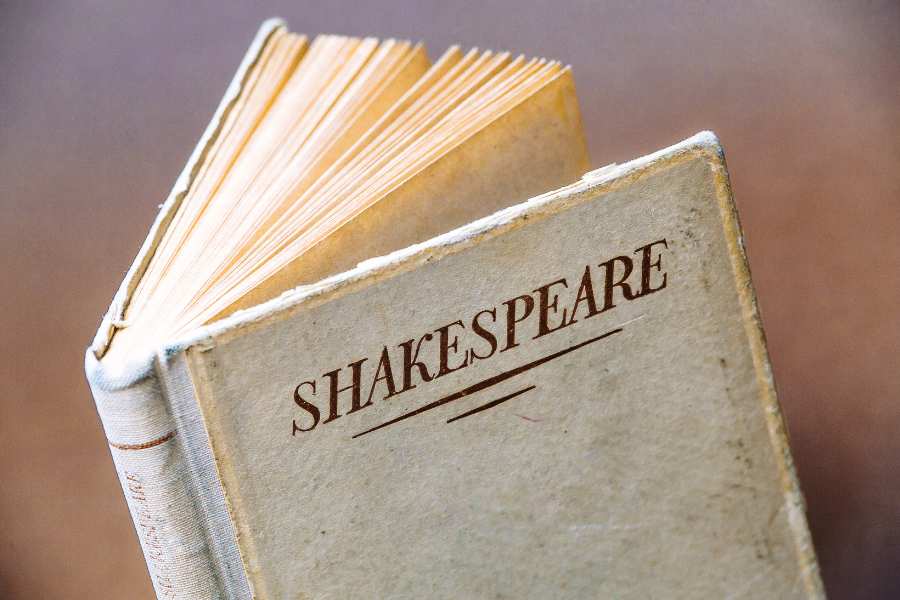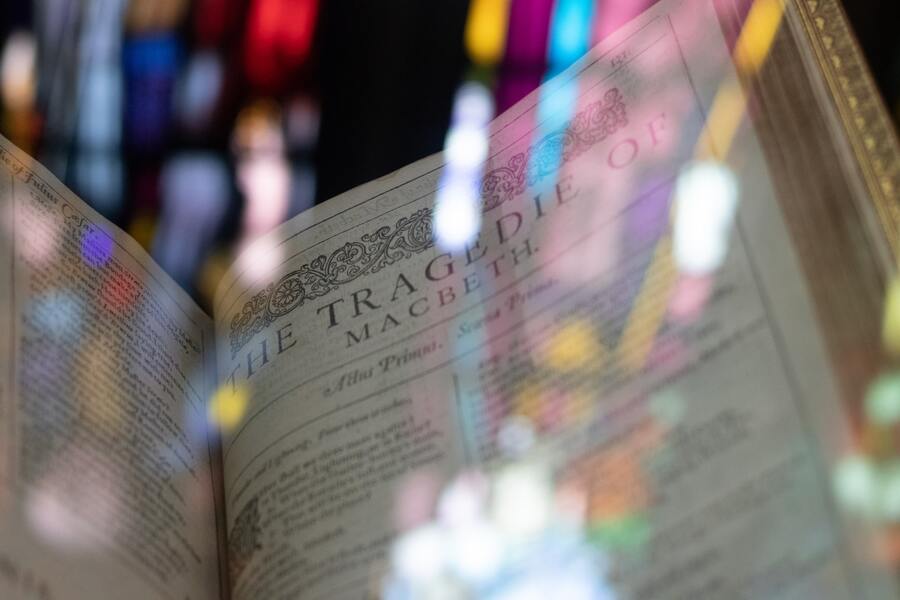Looking for motif examples to understand this abstract literary device? We got you.
We’ll hit up popular film and fiction motif examples to help you learn what it is and how to use it.
But first, a motif definition.
A motif is a repeated element appearing throughout a story that contributes to a major theme.
It’s basically bling for film and fiction, a pop of creative color that shows up to make the work more thought-provoking.
Still too abstract?
Let’s grab a few motif examples for assistance, shall we?

Motif Examples From Film & TV
We’ll start with film and TV. It’s easier to spot recurring motifs in the movies. Directors tend to be more direct. Go figure.
In film, a motif may be anything purposefully repeated, a pattern of sorts:
- a color
- an object
- a song
- a symbol
- a line of dialogue
- a camera angle or filter.
Let’s take a look…
1. The Red Coat Motif in Steven Spielberg’s Schindler’s List
One of the most dramatic uses of a recurring motif occurs in the 1993 film Schindler’s List. This holocaust film is shot in black and white with one exception, a small Jewish girl’s crimson coat.
And, just to complicate things, this coat is a symbol and a motif.
The coat’s color and the age of its wearer, symbolically represents the massacre of innocence, an obvious larger theme of the film.
Its repeated use makes it a symbolic motif.
See the difference?
The first time it pops up, the little girl is walking through a neighborhood besieged by Nazis. She walks unnoticed by all except the film’s protagonist Oskar Schindler.
His distress increases as the scene progresses; she is an innocent headed for the baddest wolf of WW2.
But keep the scarlet coat on for a little longer. Apply the theme.
It’s terribly ironic, but the scene feels more horrific when we have just one defenseless person to focus on, one spot of color to trace.
But is it a recurring image?
Indeed. The little red coat shows up later under a pile of corpses.
In this motif example, the red coat offers stark commentary on this dark time in history.
2. The Yellow Umbrella Motif in How I Met Your Mother

In a much lighter, common motif example, both literally and figuratively, a yellow umbrella is used to represent Ted Mosby’s future wife.
It opens up ten times in the popular sitcom.
Repeated? Check.
But does the umbrella contribute to a theme?
The show centers around the loves and losses of the main character Ted, an architect and hopeless romantic. And shocker, hope is the recurring theme.
Hope in the universe, hope in love, hope in happy endings.
You name it, Ted hopes for it.
Occasionally, our hero falters. Frequently, he is heartbroken. Consequently, we worry about him.
That’s when the yellow umbrella pops open, like a ray of proverbial sunshine on a metaphorically cloudy day. And, because the story is told as a really long flashback, we know it all works out.
Contribution to the overall theme, check.
But follow the yellow umbrella a tad further down Fifth Avenue.
An umbrella offers protection from the elements, something frequently shared. Symbolic significance? Hmmmm.
Isn’t Ted a yellow umbrella for his friends and us? Isn’t he a spot of hopeful sunshine for us all as we navigate our own storms of heartache?
Motif Examples from Fiction

Now that you can spot film motifs, let’s get real and uncover literary motifs.
Just like directors, writers use literary motifs to forward and add depth to their main themes.
3. The Blood Motif in Shakespeare’s The Tragedy of Macbeth
Let’s start with William Shakespeare.
The bard loves motifs. Pick any play, any major theme, and look for patterns.
In The Tragedy of Macbeth, Shakespeare uses blood as a means to trace, drop by metaphorical drop, his guilt-leads-to-madness theme.
In 2.2, after killing Duncan, Macbeth is horrified:
“Will all great Neptune’s ocean wash this blood/clean from my hand? No, this my hand will rather the multitudinous seas incarnadine, making the green one red”
(2.2. 63-66).
Let’s be honest. There is a whole lot in these lines: allusion, hypophora, hyperbole, diction, and imagery.
Squint and just focus on the blood motif.
Macbeth realizes he can never be “wash[ed]” clean of his crime. Rather, he believes his guilt (the blood) is so great that it can turn green oceans red.
Yikes.
Now, a literary motif requires a pattern, right?
The next droplet falls in Act 3.

After more murders, Macbeth darkly states he must slay to stay king:
“I am in blood/Stepped in so far that should I wade no more/ returning were as tedious as to go over”
(3.6. 21-23)
Lady Macbeth starts to splatter her own droplets in Act 5.
In 5. 1, her character connects blood and guilt in her “Out, out damn spot” speech. She ends her catatonic confession with lines that echo Macbeth’s:
“Here’s the smell of the blood still: all the/perfumes of Arabia will not sweeten this little/hand. Oh, oh, oh!”
(5.2. 50-51)
Clearly, blood is a motif.
4. The Knitting Motif in Charles Dickens’ A Tale of Two Cities
On to other literary works like novels. Let’s take a look at Charles Dickens’ A Tale of Two Cities.
And since villains are fun, let’s observe Madame DeFarge, a grand dame of the French Revolution, and her oddly conspicuous hobby, knitting.
Knitting is a calming activity, right? Typically associated with passing time and maternal figures?
Let’s see what Mdme. DeFarge’s knitting reveals about her and her associated theme, the fury of the French peasantry.
The knitting needles first appear outside Versailles. A man good-naturedly asks her what she knits. She replies, “shrouds” (Dickens 202). Her macabre diction and steady composure disturbs the man; he inches away.
Not so maternal, clearly calming.
Now let’s look for knitting patterns (and yes, that was a pun).
A few pages later, the yarn is out at her wine shop, but she isn’t knitting wine cozies.
She’s knitting two names into a revolution hit list: John Barsad, a spy, and Charles Darnay, an ex-nobleman, saying to her husband:
“they are both here for their merits”
(Dickens 216)

Almost. Barsad is guilty; Darnay is innocent. His “merit” refers to his birth, not his actions.
So the knitting motif reveals that the fury of the French peasantry is not always justified.
It also hints that Mdme. DeFarge has some deeper issues to work through.
Repeated, check.
Theme development with a side of character development, check.
5. The Moon Motif in Mary Shelley’s Frankenstein
Let’s try another villain/motif coupling, Mary Shelley’s creature in Frankenstein and la lady luna.
Celestial bodies have long been associated with archetypes, but they can also be recurring motifs.
Authors like to double-dip their literary devices.
The moon is the archetypal symbol of the feminine. Think Artemis, goddess of the moon.
Shelley uses this archetype repeatedly (ergo, a motif) to explore the theme: loss of the feminine.
We first spot this duo when the creature begins his narration. He tells Victor he only travels at night, under the gentle light of the moon.
Why?
Because darkness hides his grotesque form. And la luna continues to keep him safe until he loses his humanity and starts killing people.
Then Artemis gets annoyed.
Purposely, she shows up later.
Patterns, remember?
Late one night, Victor struggles to finish the creature’s mate. He looks up and, “by the light of the moon,” he sees the “daemon” at the window (Shelley 205). This vision causes Victor to tear the female apart (spoiler!).
Hollowing in isolation, the creature vanishes.
In this scene, Victor destroys the creature’s only chance of a female companion.
He lost his feminine. Poor Creature.
The moon reappears on Victor’s wedding night, right before his bride is murdered. A mate for a mate, Old Testament style. Recalling the event, Victor notes the moonlight:
“I felt a kind of panic on seeing the pale-yellow light of the moon illuminate the chamber”
(242)

Poor Victor.
Eh, not so much.
In this piece of literature, both characters lose their mates, and their humanity, in Shelley’s soft moonlight.
How To Choose a Motif
We’ve established that motifs add powerful depth to themes and characters.
But how do you go about creating your own motifs?
Here’s a checklist to help developing writers:
- Analyze your work like an English teacher analyzes literature.
- Identify your central idea and larger theme.
- Look at your protagonist and antagonist.
- Do you already have colors or symbols you associated with them? Can one of these be repeated purposefully?
- Film: What visual tools and tricks can you pepper throughout to contribute to your main theme and to characterization?
- Fiction: What other literary devices and literary terms can you repeat to do the same?
How To Use a Motif
Just like accessories polish an outfit, motifs are added after a story is completed.
So, once you are done composing, return to pivotal scenes where conflict and characters are challenged.
These make perfect places to plop in multiple motifs. Just be sure to follow these three rules:
- Limit your total number of motifs. To start, stick to one per theme/character.
- Place them purposefully in your creative writing.
- Limit use, otherwise, they lose potency.
Motif Examples, Check! Mastery Achieved, Check!
Now that we’ve demystified this literary device, go out and find them for yourself. Awe your peers with your keen eye and mean analytical skills.
And, if you are up to the challenge, go into your own stories and accessorize!
Dress them up for the ball with a few flashes of your own motif gold.
The post 5 Motif Examples From Film & Fiction (+ Definition) appeared first on Smart Blogger.

No comments:
Post a Comment